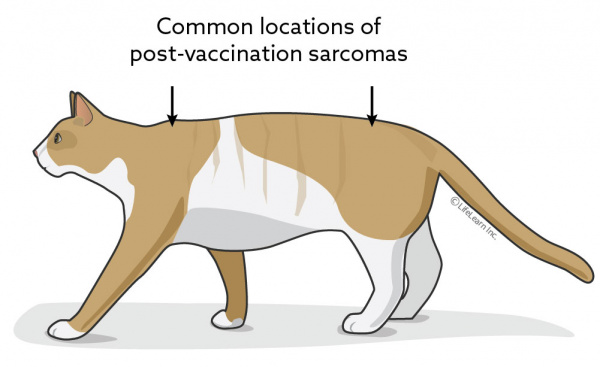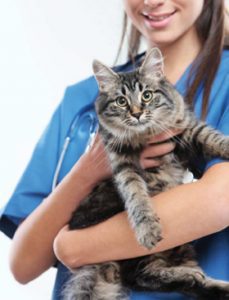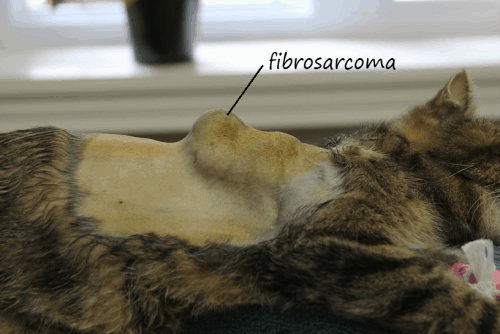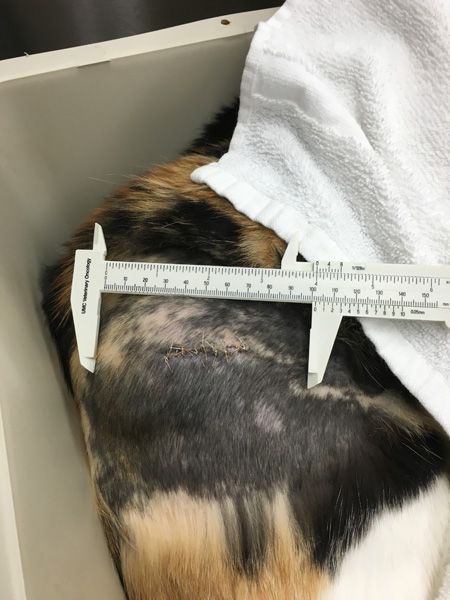sarcoma in cats prognosis
Sadly one in five cats get cancer. Treatment combining surgery chemotherapy and radiation therapy significantly increases the tumor free time to 18-24 months.

Feline Injection Site Sarcomas Risk Factors Diagnosis Staging And Treatment Algorithm Today S Veterinary Practice
It is likely that cats that develop fibrosarcomas at injections sites are genetically predisposed to developing cancer.

. These cells can form a tumour called a fibrosarcoma. Cats with fibrosarcoma or nerve sheath tumor had significantly longer survival times when compared with cats with malignant fibrous histiocytomas. Oral tumors are the fourth most common type of tumor affecting cats and unfortunately most of them are malignant.
Lymphoma squamous cell carcinoma mast cell tumour and bone cancer are all common in cats. There are other causes of inflammation that can lead to a sarcoma. Reported median survival times were 640 days versus 645 days versus 290 days respectively.
Typically fibrosarcomas are difficult to treat and a cure is unlikely. What are some of the symptoms of feline cancers. Post-vaccination sarcomas usually involve the fibrous connective tissue under the skin and are often fibrosarcomas.
At home pet owners need to keep the cat from scratching biting licking or rubbing the. Sixty-five of 80 VAS 81 exhibited positive immunoreactivity with Mab240 a murine monoclonal antibody that specifically recogniz. Most soft tissue sarcomas are heterogenous and are solitary tumors that have no breed or sex predilection.
8 rows The prognosis for cats with injection-site sarcomas depends on several variables. Eighty spontaneously occurring feline vaccine-associated sarcomas VAS were evaluated to determine the immunohistochemical expression of the tumor suppressor gene p53. A tumor that develops at the site of a vaccine injection such as for rabies or.
Mesenchymal tissues include connective tissues such as skin and muscles bone cartilage peritoneum and blood vessels. The prognosis for cats with fibrosarcoma varies based on the stage and spread of the mass. This is one reason you want to ensure your cat has regular wellness visits to the veterinarian.
Chemotherapy may be used in addition to surgery or radiation or it may be used as a stand-alone treatment. In other words the lower the grade of sarcoma the better. We see a tumor called fibrosarcoma or soft tissue sarcoma which is a tumor developing in muscle or in the connective tissue of the body.
Regardless of the site some symptoms are common to all lymphomas. Soft tissue sarcomas account for approximately 7 of skin and subcutaneous tumors in cats. The cancer that develops at injection sites is called fibrosarcoma.
They can be wide plaques or lumps. Typically they are shiny pink hairless nodules on the skin but there are many variations on this. The prognosis for a cat with stomach cancer depends on the type of cancer and how advanced the cancer is at the time of diagnosis.
The rate of surviving depends on the grade of the feline tumor. If your cat has neurological symptoms nervous system involvement you may notice changes in behavior difficulty in walking and fits. A veterinary pathologist can give the vet and cat owner a prognosis which gives the cat owner a probability of recurrence of the cancer or a metastasis of the cancer to other parts of the cats body.
If the cat dies from fibrosarcoma it is likely because of the recurrence of primary site tumors. Thats the one associated with injections and vaccinations which some people call injection-site sarcoma. Symptoms of Feline Soft-Tissue Sarcomas.
A cat with gastric lymphoma can be expected to survive an average of six months with chemotherapy although a cat that initially responds favorably to chemotherapy can be expected to survive for over a year on average. What is the prognosis. It is an extremely invasive form of cancer.
Cat cancer symptoms can be subtle and cats are good at. Like all cancer treatments the earlier a tumor is detected and treated the longer your cat is likely to survive. With a low grade tumor the situation is less serious because the aggressiveness is not as strong as a tumor that is categorized as high grade.
While a cancer diagnosis is emotionally devastating some cancers are treatable if caught early. They often occur in middle-to older-aged animals which is consistent with the signalment of this case. Squamous cell carcinoma is the most common type of tumor and often aggressively spreads to surrounding tissues so prompt diagnosis and treatment are vital to maximize your pets chances of a successful outcome.
Chewy Pharmacy is that Simple. A mass that you can feel. In terms of appearance soft tissue sarcomas often present as.
Chemotherapy consists of four to six treatments given at three-week intervals. Another treatment option is chemotherapy. It is usually chosen to treat tumors with a higher likelihood of metastasis but can also be used as an effective method to target cancer cells in cats with vaccine-associated sarcomas.
A sarcoma is a term for any cancer of mesenchymal tissues. Cutaneous mast cell tumors present as lumps swellings or lesions in the skin or under the skin usually around the head and neck but sometimes elsewhere. Lachowicz explains that soft-tissue sarcomas may be less aggressive with progression occurring over weeks to.
While older cats are most often affected lymphoma can happen at any age. Although the prognosis with radiation therapy varies depending on the type of tumor many cats will show an improvement in clinical signs and may go onto live for years after radiation therapy. Ad We Offer the Same Medications As Your Vet at Great Prices.
The symptoms of a soft-tissue sarcoma depend on its location on a cat. Ad Get NHVs Cancer Fighter Pack for your cat and help support the immune system naturally. The following are just four types of sarcomas in cats.
Cats are tricky because they hide disease. Cats with tumors on the legs where an amputation can be performed appear to do better than cats with tumor on the trunk of the body. The clinical signs of feline mast cell tumors depend on the location of the tumor.
Add your Vet and Pet Rx info then Chewy Handles the Rest. However the predominant symptoms are. Vet formulated to support your pets complete body in the fight against cancer.
This is a cancerous growth presenting as a mass on the body or leg of a cat. Injection-site sarcomas in cats are very difficult to treat.

Feline Injection Site Sarcoma Today S Veterinary Practice

Learn About Soft Tissue Sarcomas In Cats Petcure Oncology

Feline Injection Site Sarcoma Improve International

Injection Site Sarcomas In Cats Good Pet Parent

Selected Prognostic Factors For Mammary Cancer In Cats Download Table

Tumors Of The Skin In Cats Cat Owners Merck Veterinary Manual

Managing Fibrosarcoma In Cats And Dogs Mommy S Memorandum

Post Vaccination Sarcoma In Cats Vca Animal Hospitals

The Continuing Conundrum Of Feline Injection Site Sarcomas American Veterinary Medical Association

Cat Injection Site Sarcoma The Risks Treatment Prognosis Of This Deadly Tumor Our Pet S Health

Feline Injection Site Sarcomas Update

Pdf Malignant Mammary Tumors Biologic Behavior Prognostic Factors And Therapeutic Approach In Cats

Feline Injection Site Sarcomas Risk Factors Diagnosis Staging And Treatment Algorithm Today S Veterinary Practice

Feline Injection Site Sarcomas The Veterinary Nurse
/GettyImages-11673268481-ff230807a7e04e2db8e38e148edb19a5.jpg)
